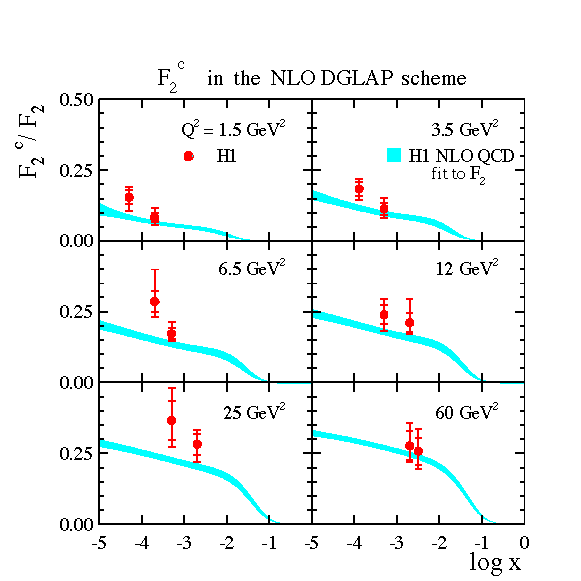Measurement of D*+/- Meson Production and F2c
in Deep-Inelastic Scattering at HERA
|
How charming is the proton?
Protons, we have all heard, are made of quarks. In fact,
we all know they are made of three quarks, two being 'up' or 'u' quarks
and the third being a 'down' or 'd' quark. When we look at protons using
a strong enough microscope, and HERA is the world's most powerful electron
microscope, we would expect to be able to see those quarks, and indeed
we do. However, the microscope also reveals some puzzles:
-
In addition to the quarks we expect, we see a huge 'sea'
of other quarks and anti-quarks. (An anti-quark, is the anti-matter partner
of a quark, e.g. a u and a u respectively and, as we know from Star Trek,
if the two meet they annihilate each other in a flash of energy.)
-
If we measure the contribution all these quarks make to the
punch a proton packs when it hits something, we find that it adds up to
only about half the total we expect; there must be something else in there
that carries momentum.
The theory that explains how quarks interact with each other
tells us that this 'something else' is the gluons which carry the force
between the quarks. This theory, called Quantum Chromo-Dynamics or QCD
for short, says that quarks can only stick together
to form protons by continually swapping gluons. It also
says that the unexpected sea of quarks arises because sometimes the gluons
that are being exchanged between quarks split to form quark/anti-quark
pairs. So can we test these ideas? Yes we can!
QCD says that some of the quark/anti-quark pairs produced
when gluons split are u/anti-u and d/anti-d pairs, but that we should also
find both 'strange' and 'charmed', s/anti-s and c/anti-c, pairs in the
mix. So if we can't find these in the proton, we had better scrap QCD.
Strange quarks are hard to find, but charmed quarks form D* mesons, and
these leave a characteristic signature in the microscope pictures taken
by HERA.
 |
| This picture shows the fraction of c and anti-c quarks
seen in the proton (red points) and the QCD DGLAP prediction at different
values of x, the proportion of the proton's momentum carried by the quarks,
and for various values of the magnification at which the proton is studied,
which increases as Q2 gets larger. |
The experiment described in this paper involved searching through millions
of pictures taken using the H1 'camera' at HERA and looking for those in
which charm quarks were found in the proton. Amazingly, the pictures reveal
that about a quarter of the quarks in the proton are c/anti-c pairs; F2c
is about 1/4 . So is this what QCD expects?
This question is a difficult one. A few years ago we would have said
'No, it's too many'! That is because we can only work out approximately
how many c quarks we expect to see, and calculations, based on the
'DGLAP' approximation, give fewer charm quarks than observed, as is shown
in the picture above. Recent calculations
using the more accurate 'CCFM' approximation give results closer to what
we have measured. So what have we learned?
-
QCD is right; there really are charmed quarks in the proton.
-
Of the two types of QCD calculation tested, those made using the CCFM approximation
are more accurate than those that use the older DGLAP approach.
Where do we go from here? More precise measurements and better calculations
will be needed to test our ideas about how quarks, charmed or otherwise,
are held together inside the proton.
